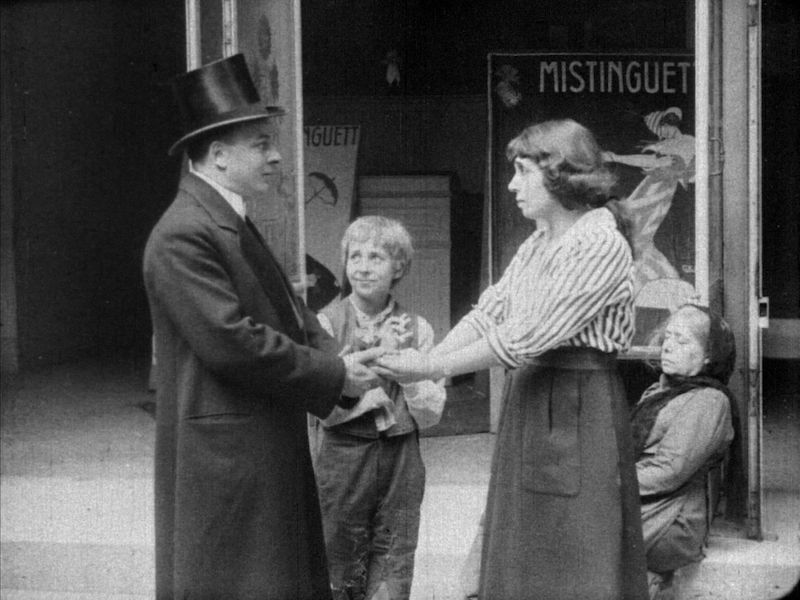FLEUR DE PARIS
André Hugon (FR 1916)
In Chignon d’or, Mistinguett played multiple roles: preparing to perform in her new play, she disguised herself as a streetwalker and then had to escape danger by becoming a newsboy. Fleur de Paris has her playing herself in a double role as two very different characters. One role has her performing as a music hall star, whose popularity leads an American impresario to lure her with a lucrative offer to tour the United States. This role allows her to don furs and striking headdresses, show off her famous leg kicks, and perform a mildly risqué number with her partner Harry Podge. The other role turns her into Margot Panard, a young working-class dressmaker lured to the theater by posters of Mistinguett; she splurges on a balcony ticket and is so excited by the star’s performance that she dreams of taking her place with Podge. This extravagance, after she apparently is fired from her job, has dire consequences for her poor family: unable to pay the neighborhood baker, she escapes by dropping from a window onto a passing car and eventually becomes a street flower-seller; her mother and younger brother Riri are reduced to poverty (the unemployed father disappears). Through a series of coincidences typical of such melodramas, Margot meets Podge, who is struck by her resemblance to Mistinguett. The film’s climax, however, does not have her performing with Podge; instead he takes her to his well-furnished apartment, invites Riri and her mother to join them (now a couple), and stage-manages a final tableau reconstituting Margot’s family at a higher social level.
Much like Chignon d’or, Fleur de Paris is notable for its location filming in and around Paris. At times the filming involves crowds near the theater or a puppet show (where Margot is selling flowers), and people often are looking and smiling at the camera, as in early actualités, making
le peuple the center of attention and a reflection of the viewing audience. This gives the film an unexpected sense of its own multi-layered production, as does Mistinguett’s occasional wink or nod to the camera. At the same time, realistic details stand out: the mother and Riri sitting dejectedly on the stone steps at the theater’s entrance; the exchange between Riri at the apartment window and his father and the grocer in the street below; Margot naïvely unaware that she should tip the woman who guides her to a balcony seat, or later, that she still has paper curlers in her hair as she uses a shop window to make herself look like Mistinguett; even the cluttered apartment kitchen (with its selective lighting) that uncannily resembles the kitchen in Lois Weber’s Shoes (1916). An especially poignant moment comes when Mistinguett arrives at the theater entrance and stops briefly near Margot’s mother, who cries out, as if traumatized, thinking she is her daughter.
Mistinguett’s double role becomes fascinating in the context of the Great War as well as of her alleged work as a double agent. On the one hand, the film’s one plot line seems to accept a woman’s single-minded desire for a professional career, even if that leads her, as a popular Parisian music hall star, to betray her partner and country — but does that serve implicitly to link France and the United States, which, in late 1916, had yet to enter the war? On the other hand, the second, more important plot line tracks Margot’s lively presence, her infatuation with the theater, her improbable dream, and her destitution. The melodramatic realization of that dream, however, returns her to the domestic sphere, where she is inscribed within a family that is rather unconventional yet very paternalistic — in dressing her, Podge seems intent on turning Margot into Mistinguett, a bit like Jimmy Stewart’s much more creepy behavior in Vertigo. In the end, the film proves a crafty vehicle: it not only showcases Mistinguett’s stardom (perhaps displacing her wartime “betrayal”), but it also retells her own rags-to-riches story.
Richard Abel


regia/dir: André Hugon.
scen: Gem.
cast: Mistinguett (Mistinguett / Margot Panard), Harry Baur (Harry Podge), Louis Paglieri (Brackson), Guita Dauzon (mamma/mère Panard), Marc Gérard.
prod: Films Succès. uscita/rel: 03.11.1916.
copia/copy: DCP, 43′ (da/from 35mm, incomp., 802 m., 16 fps); did./titles: FRA.
fonte/source: CNC – Centre national du cinéma et de l’image animée, Bois d’Arcy.




